卫星海洋学
- 格式:doc
- 大小:546.50 KB
- 文档页数:27
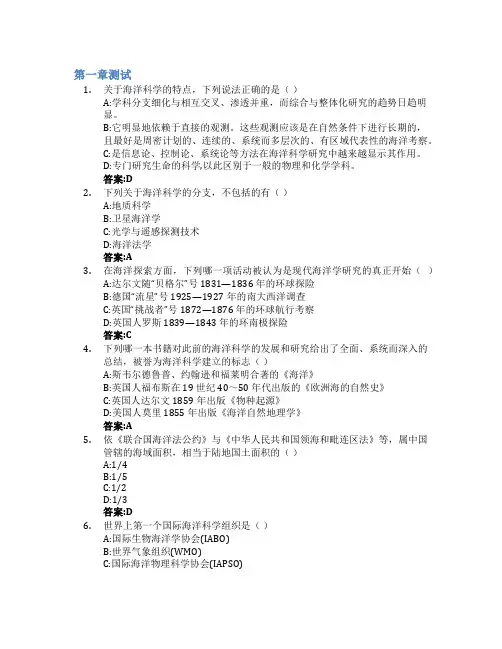
第一章测试1.关于海洋科学的特点,下列说法正确的是()A:学科分支细化与相互交叉、渗透并重,而综合与整体化研究的趋势日趋明显。
B:它明显地依赖于直接的观测。
这些观测应该是在自然条件下进行长期的,且最好是周密计划的、连续的、系统而多层次的、有区域代表性的海洋考察。
C:是信息论、控制论、系统论等方法在海洋科学研究中越来越显示其作用。
D:专门研究生命的科学,以此区别于一般的物理和化学学科。
答案:D2.下列关于海洋科学的分支,不包括的有()A:地质科学B:卫星海洋学C:光学与遥感探测技术D:海洋法学答案:A3.在海洋探索方面,下列哪一项活动被认为是现代海洋学研究的真正开始()A:达尔文随“贝格尔”号 1831—1836 年的环球探险B:德国“流星”号 1925—1927年的南大西洋调查C:英国“挑战者”号1872—1876 年的环球航行考察D:英国人罗斯 1839—1843 年的环南极探险答案:C4.下列哪一本书籍对此前的海洋科学的发展和研究给出了全面、系统而深入的总结,被誉为海洋科学建立的标志()A:斯韦尔德鲁普、约翰逊和福莱明合著的《海洋》B:英国人福布斯在 19 世纪 40~50 年代出版的《欧洲海的自然史》C:英国人达尔文 1859 年出版《物种起源》D:美国人莫里 1855 年出版《海洋自然地理学》答案:A5.依《联合国海洋法公约》与《中华人民共和国领海和毗连区法》等,属中国管辖的海域面积,相当于陆地国土面积的()A:1/4B:1/5C:1/2D:1/3答案:D6.世界上第一个国际海洋科学组织是()A:国际生物海洋学协会(IABO)B:世界气象组织(WMO)C:国际海洋物理科学协会(IAPSO)D:国际海洋考察理事会(ICES)答案:D7.、趋使海水的运动的力不包括()A:自转偏向力B:风应力C:弹力D:重力答案:C8.谁最先发现了海洋原生动物()A:英国人牛顿B:英国人玻意耳C:荷兰人列文虎克D:瑞士人贝努利答案:C9.下列哪一项不属于人类把更多的目光投向海洋的原因()A:海洋科学在历经古代、近代和现代的发展之后,必将迎来一个更为辉煌的新时代。
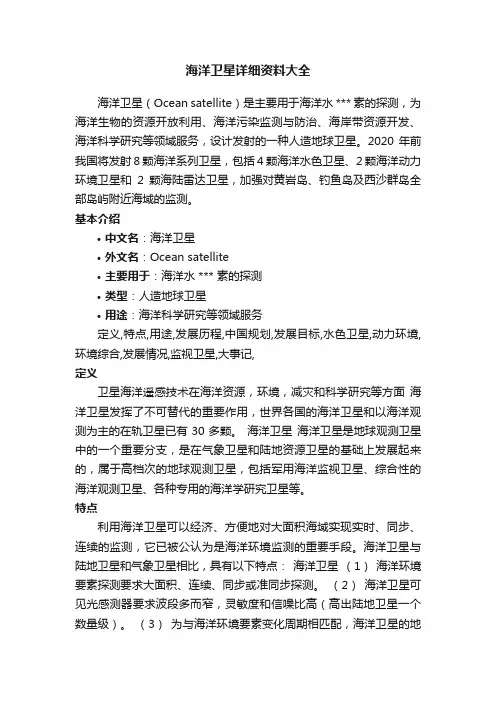
海洋卫星详细资料大全海洋卫星(Ocean satellite)是主要用于海洋水 *** 素的探测,为海洋生物的资源开放利用、海洋污染监测与防治、海岸带资源开发、海洋科学研究等领域服务,设计发射的一种人造地球卫星。
2020年前我国将发射8颗海洋系列卫星,包括4颗海洋水色卫星、2颗海洋动力环境卫星和2颗海陆雷达卫星,加强对黄岩岛、钓鱼岛及西沙群岛全部岛屿附近海域的监测。
基本介绍•中文名:海洋卫星•外文名:Ocean satellite•主要用于:海洋水 *** 素的探测•类型:人造地球卫星•用途:海洋科学研究等领域服务定义,特点,用途,发展历程,中国规划,发展目标,水色卫星,动力环境,环境综合,发展情况,监视卫星,大事记,定义卫星海洋遥感技术在海洋资源,环境,减灾和科学研究等方面海洋卫星发挥了不可替代的重要作用,世界各国的海洋卫星和以海洋观测为主的在轨卫星已有30多颗。
海洋卫星海洋卫星是地球观测卫星中的一个重要分支,是在气象卫星和陆地资源卫星的基础上发展起来的,属于高档次的地球观测卫星,包括军用海洋监视卫星、综合性的海洋观测卫星、各种专用的海洋学研究卫星等。
特点利用海洋卫星可以经济、方便地对大面积海域实现实时、同步、连续的监测,它已被公认为是海洋环境监测的重要手段。
海洋卫星与陆地卫星和气象卫星相比,具有以下特点:海洋卫星(1)海洋环境要素探测要求大面积、连续、同步或准同步探测。
(2)海洋卫星可见光感测器要求波段多而窄,灵敏度和信噪比高(高出陆地卫星一个数量级)。
(3)为与海洋环境要素变化周期相匹配,海洋卫星的地面覆蓋周期要求2~3天,空间解析度为250~1000m。
(4)由于水体的辐射强度微弱,而要使辐射强度均匀,具有可对比性,则要求水色卫星的降交点地方时(发射视窗)选择在正午前后。
(5)某些海洋要素的测量,例如海面粗糙的测量、海面风场的测量,除海洋卫星探测技术外,尚无其他办法。
用途海洋卫星有六个方面的用途。
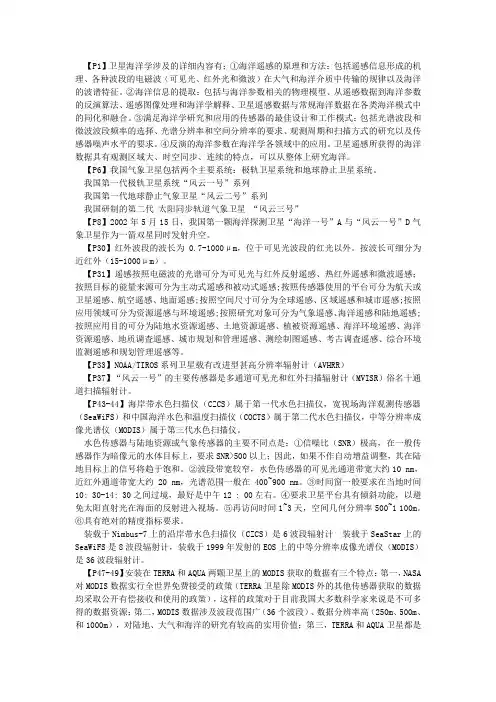
【P1】卫星海洋学涉及的详细内容有;①海洋遥感的原理和方法:包括遥感信息形成的机理、各种波段的电磁波(可见光、红外光和微波)在大气和海洋介质中传输的规律以及海洋的波谱特征。
②海洋信息的提取:包括与海洋参数相关的物理模型、从遥感数据到海洋参数的反演算法、遥感图像处理和海洋学解释、卫星遥感数据与常规海洋数据在各类海洋模式中的同化和融合。
③满足海洋学研究和应用的传感器的最佳设计和工作模式:包括光谱波段和微波波段频率的选择、光谱分辨率和空间分辨率的要求、观测周期和扫描方式的研究以及传感器噪声水平的要求。
④反演的海洋参数在海洋学各领域中的应用。
卫星遥感所获得的海洋数据具有观测区域大、时空同步、连续的特点,可以从整体上研究海洋。
【P6】我国气象卫星包括两个主要系统:极轨卫星系统和地球静止卫星系统。
我国第一代极轨卫星系统“风云一号”系列我国第一代地球静止气象卫星“风云二号”系列我国研制的第二代太阳同步轨道气象卫星“风云三号”【P8】2002年5月15日,我国第一颗海洋探测卫星“海洋一号”A与“风云一号”D气象卫星作为一箭双星同时发射升空。
【P30】红外波段的波长为0.7-1000μm,位于可见光波段的红光以外。
按波长可细分为近红外(15-1000μm)。
【P31】遥感按照电磁波的光谱可分为可见光与红外反射遥感、热红外遥感和微波遥感;按照目标的能量来源可分为主动式遥感和被动式遥感;按照传感器使用的平台可分为航天或卫星遥感、航空遥感、地面遥感;按照空间尺寸可分为全球遥感、区域遥感和城市遥感;按照应用领域可分为资源遥感与环境遥感;按照研究对象可分为气象遥感、海洋遥感和陆地遥感;按照应用目的可分为陆地水资源遥感、土地资源遥感、植被资源遥感、海洋环境遥感、海洋资源遥感、地质调査遥感、城市规划和管理遥感、测绘制图遥感、考古调査遥感、综合环境监测遥感和规划管理遥感等。
【P33】NOAA/TIROS系列卫星载有改进型甚高分辨率辐射计(AVHRR)【P37】“风云一号”的主要传感器是多通道可见光和红外扫描辐射计(MVISR)俗名十通道扫描辐射计。

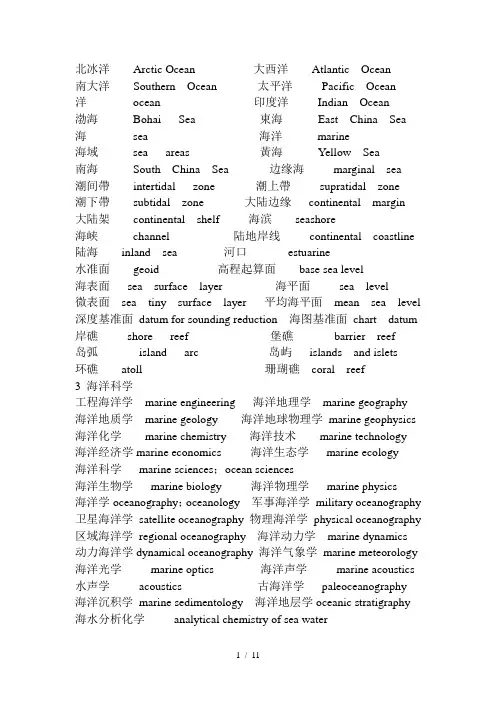
北冰洋Arctic Ocean 大西洋Atlantic Ocean南大洋Southern Ocean 太平洋Pacific Ocean洋ocean 印度洋Indian Ocean渤海Bohai Sea 東海East China Sea海sea 海洋marine海域sea areas 黃海Yellow Sea南海South China Sea 边缘海marginal sea潮间帶intertidal zone 潮上帶supratidal zone潮下帶subtidal zone 大陆边缘continental margin大陆架continental shelf 海滨seashore海峡channel 陆地岸线continental coastline 陆海inland sea 河口estuarine水准面geoid 高程起算面base sea level海表面sea surface layer 海平面sea level微表面sea tiny surface layer 平均海平面mean sea level 深度基准面datum for sounding reduction 海图基准面chart datum 岸礁shore reef 堡礁barrier reef岛弧island arc 岛屿islands and islets环礁atoll 珊瑚礁coral reef3 海洋科学工程海洋学marine engineering 海洋地理学marine geography海洋地质学marine geology 海洋地球物理学marine geophysics 海洋化学marine chemistry 海洋技术marine technology海洋经济学marine economics 海洋生态学marine ecology海洋科学marine sciences;ocean sciences海洋生物学marine biology 海洋物理学marine physics海洋学oceanography;oceanology 军事海洋学military oceanography 卫星海洋学satellite oceanography 物理海洋学physical oceanography 区域海洋学regional oceanography 海洋动力学marine dynamics动力海洋学dynamical oceanography 海洋气象学marine meteorology 海洋光学marine optics 海洋声学marine acoustics 水声学acoustics 古海洋学paleoceanography海洋沉积学marine sedimentology 海洋地层学oceanic stratigraphy 海水分析化学analytical chemistry of sea water海洋地球化学marine geochemistry 海洋生物化学marine biochemistry 海洋物理化学marine physical chemistry 河口化学estuarine chemistry 初级生产力primary productivity 海洋生态系(统)marine ecosystems 渔业海洋学fisheries oceanography 海洋生物学marine organism海岸带资源coastal zone resources 海底资源submarine resources 海底矿产【资源】submarine mineral [resources]海水化学资源marine chemistry resources海水【水】资源sea water resource 海洋可再生资源ocean reproducible resources海洋空间【资源】ocean space [resource] 海洋能marine energy resources 海洋生物资源marine biological resources海洋药物marine pharmaceuticals海洋资源marine resources海洋产业ocean industry 海洋经济marine economy 海洋开发marine exploitation 海洋旅游sea tourism海洋农牧化sea farming and ranching 海洋倾倒区dumping zone at sea 海洋渔业marine fishery 海洋资源保护marine resources protection 多金属结核polymetallic nodule, multimetal nodule多金属结壳polymetallic encrustation 多金属泥metalliferous mud 海底地壳热流sea-bottom hot flow 海底砂矿submarine placer海底热液矿床submarine hydrothermal deposits海底油田submarine oil field 反渗透reverse osmosis,RO电渗祈[脱盐] electrodialysis [desalination],ED 海水sea water海水淡化sea water desalination 海水直接利用direct use of seawater 苦咸水bitter and salty water膜[水处理]元件membrane[water treatment] element[水处理]膜[water treatment]membrane水处理设备the equipment for water treatment蒸馏[淡化]法distillation process for desalination海上人工岛marine artificial island海上养殖工程mariculture engineering海上油气开发工程exploitative engineering of offshore petroleumexploitative engineering of gas reservoir海洋工程ocean engineering 海洋工程地质marine engineering geology 海洋工程环境marine engineering environment大陆架公约convention on the continental shelf地理不利国geographically disadvantaged state防倾倒公约prevent dumping convention伦敦倾废公约London dumping convention 公海high seas公海公约convention on the high seas 海洋政策marine polity国际海洋法international law of the sea 海图sea chart海洋功能区划division of marine functional zonation海洋法law of the sea 海洋权right of the sea海域划界delimitation of boundaries on the sea海洋法公约UN Convention on the Law of the Sea领海territorial sea 领水territorial water领海基点territorial sea base point 领海基线baseline of territorial sea 领海宽度breadth of the territorial sea领海的司法管辖权judicial jurisdiction over territorial sea领海通过批准制度ratify regime on territorial sea through领海外部界限outer limit of the territorial sea 水internal waters领海主权sovereignty of the territorial sea 毗连区contiguous zone 群岛海道通过archipelagic sea lanes passage群岛基线archipelagic baseline 群岛水域archipelagic water群岛制度institution of archipelago 群岛原则regime of archipelago 定常基线normal baseline 直线基缝straight baseline专属经济区exclusive economic zone 专属渔区exclusive fishing zone 管理management 海岸带管理coastal zone management 海藉sea area use register 海藉管理management of sea area use register 海上倾倒dumping at sea 岛屿管理management of sea islands 海洋管理marine management海洋行业管理management by marine trades海洋环境管理marine environmental management海洋权益管理marine right and interests management海洋资源管理marine resources management海域使用法律制度legal regime for the sea area use海域使用管理management of the sea area use海域使用论证feasibility assessment of the sea area use海洋环境marine environment海洋环境保护marine environmental protection海洋环境评价marine environmental assessment海洋环境污染损害marine environmental pollution damage海洋环境影响评价marine environmental impact assessment海洋环境质量marine environmental quality海洋环境质量评价marine environmental quality assessment海洋[环境]自然保护区marine[environmental] nature reserve;marine protected area海洋污染控制marine pollution control 海洋污染物marine pollutant 海洋污染物背景值marine pollutant background潮流预报tidal current forecast 海冰预报sea ice forecast风暴潮预警报storm surge forecasting and warning海浪预报ocean wave forecast 海啸警报tsunami forecast海洋环境警报marine environmental alarm海洋环境预报marine environmental forecasting;marine environmental prediction海洋数值预报numerical forecast of marine海洋灾害评估disaster assessment of marine[海洋]地质勘探 geologic prospecting 大面观测sea area observation [海洋]调查oceanographic survey; oceanographic investigation海洋环境监测marine environment monitoring海洋环境监视marine monitoring 定点观测fixed point observation 标准断面调查standard selection investigation定时观测timed observation 断面观测sectional observation辅助观测opportune observation[海洋]常规监测continuous observation海洋连续观测continuous observation[海洋]遥感[观测] [marine]remote sensing[observation][海洋]走航观测[ocean]cruising observation海洋反演数据oceanographic inversion data海洋历史数据(信息、资料)oceanographic history data (information、material) 海洋实测数据oceanography observed data海洋实时数据oceanography timely data标准体系standards system 海洋标准marine standard海洋标准化oceanography standardization ; marine standardization技术法规technical regulation 海洋计量oceanographic metrology 国家法定计量单位national legal unit of measurement[海洋计量器具的]检定verification[of a oceanographic measuring instrument] 海洋[特殊]量marine quantity 海洋要素marine elements 海洋[特殊]量值marine value[of a marine quantity]参比性能特性reference performance characteristic附加误差additive error 海洋测量仪器oceanographic instrument [海洋测量仪器的]计量性能metrological characteristic [of a oceanographic instrument][海洋测量仪器的]准确度accuracy [of a oceanographic instrument [海洋测量仪器]响应时间response time [of a oceanographic instrument] [海洋测量仪器]响应特性response characteristic [of a oceanographic instrument][海洋测量仪器]影响量influence quantities [of a oceanographic instrument][海洋测量仪器]准确度等级accuracy class [of a oceanographic instrument]海洋仪器设备oceanographic instruments and equipments[海洋仪器设备]安全性safety [of a oceanographic instrument][海洋仪器设备]参考条件reference conditions [of a oceanographic instrument];reference conditions [of a marine instrument][海洋仪器设备]额定操作条件rated operating conditions [of a oceanographic instrument];rated operating conditions [of a marine instrument];[海洋仪器设备]极限条件limiting conditions [of a oceanographic instrument];limiting conditions [of a marine instrument];[海洋仪器设备]互换性interchangeability [of a oceanographic instrument];interchangeability [of a marine instrument];[海洋仪器设备]环境适应性environment applicability [of a oceanographic instrument];environment applicability [of a marine instrument];[海洋仪器设备]可靠度reliability [of a oceanographic instrument];reliability [of a marine instrument];[海洋仪器设备]可靠性reliability [of a oceanographic instrument];reliability performance[of a marine instrument];[海洋仪器设备]可信性creditability [of a oceanographic instrument];creditability [of a marine instrument];[海洋仪器设备]配套性suitability [ of a oceanographic instrument ]suitability [of a marine equipment][海洋仪器设备]通用要求general specifications[of a marine equipment] general specifications [ of a oceanographic instrument ] [海洋仪器设备]相容性compatibility [of a marine equipment] compatibility [ of a oceanographic instrument ][海洋仪器设备] 性能特性performance characteristic [ of a oceanographic instrument ]performance characteristic [of a marine equipment]基本误差intrinsic error有证参考物质certified reference material ,CRM(缩写)海水sea water 海面水温sea surface temperature(SST)现场温度insitu temperature 等温线isotherm温度深度图bathythermogram 暖水舌warm water tongue冷水舌cold water tongue 暖水圈warm water sphere冷水圈cold water sphere 盐度salinity1978实用盐标Practical Salinity Scale 1978(PSS 78)绝对盐度absolute salinity 实用盐度practical salinity等盐线isohaline 盐舌salinity tongue盐指salt finger 盐【水】楔salt water wedge热盐结构thermohaline structure 海水密度sea water density现场密度insitu density 密度超量density excess海水比容specific volume of sea water 现场比容insitu specific volume 比容偏差specific volume anomaly 热比容偏差thermosteric anomaly 铅直稳定度vertical stability 对流混合convective mixing涡动混合turbulent mixing 潮混合tidal mixing【混合】增密cabbeling,caballing 温跃层thermocline主【温】跃层main thermocline 季节性【温】跃层seasonal thermocline 盐跃层halocline 密度跃层pycnocline波internal wave 拟置层inversion layer均匀层homogeneous layer 混合层mixed layer ,mixing layer大洋对流层oceanic troposphere 层化海洋stratified ocean冷涡cold eddy 暖涡warm eddy水型water type 水团water mass水系water system 表层水surface water次表层水subsurface water 中层水intermediate water深层水deep water 底层水bottom water沿岸水coastal water 中央水central water南极绕极水团Antarctica Circumpolar Water Mass北极水Arctic water ; North Polar Water副热带模态水subtropical mode water黄海冷水团Huanghai(Yellow Wea)Cold Water Mass长江冲淡水Changjiang Diluted Water ; Changjiang River Plume 赤道辐合带Equatorial Convergence Zone 海洋锋oceanic front细结构finestructure 微结构microstructure 海面斑带slick 海洋湍流oceanic turbulence双扩散double diffusion 海水状态方程sea water state equation 海色sea colour 水色water colour海水透明度sea water transparency 海流ocean current总环流general circulation 大洋环流ocean circulation热盐环流thermohaline circulation 热盐对流thermohaline convection 深渊环流abyssal circulation 赤道流equatorial current漂流drift current 西风漂流west wind drift南极绕极流Antarctic Circumpolar Current西边界流western boundary current 风海流wind-driven current地转流geostrophic current 密度流density current坡度流slope current 信风海流trade wind current季风海流monsoon current 补偿流compensation current 逆流counter current赤道逆流Equatorial Counter current赤道潜流Equatorial Under current太平洋赤道潜流Pacific Equatorial Under current大西洋赤道潜流Atlantic Equatorial Under current印度洋赤道潜流Indian Equatorial Under current上升流:upwelling 下降流:downwelling沿岸流:coastal current 渤海沿岸流:Bohai Coastal Current 黄海沿岸流:Huanghai(Yellow Sea)Coastal Current东海沿岸流Donghai (East China Sea)Coastal Current南海沿岸流:Nanhai (South China Sea)Coastal Current顺岸流longshore current 表层流surface current次表层流subsurface current 深层流deep current底层流bottom current 暖流:warm current黄海暖流:Huanghai (Yellow Sea)Warm current暖流:Taiwan Warm current黑潮:Kuroshio南海暖流:Nanhai (South China Sea)Warm current对马海流:Tsushima Current 湾流:Gulf Stream寒流:cold current 亲潮:oyashio余流:residual current 流涡:gyre流环ring 体积运输volume transport动力方法:dynamic method 无运动面:level of no motion位势高度:potential height 风因子wind factor埃克曼漂流Ekman drift current 埃克曼深度Ekman depth埃克曼层Ekman layer 埃克曼螺旋Ekman spiral埃克曼输运Ekman transport 埃克曼抽吸Ekman pumping 底摩擦层bottom friction layer 斜压海洋baroclinic ocean正压海洋barotropic ocean 中尺度涡mesoscale eddy卷吸entrainment 波流wave-induced current(wave current)裂流rip current 海浪ocean wave风区fetch 风时wind duration最小风区minimum fetch 最小风时minimum duration等效风区equivalent fetch 等效风时equivalent duration波高wave height 有效波significant wave波周期wave period 波陡wave steepness波龄wave age 波候wave climate毛细波capillary wave 重力波gravitational wave孤立波solitary wave 边沿波edge wave陆架波shelf wave 潜水波shallow water wave 深水波deep water wave 浅水系数shoaling factor短峰波short—crested wave 长峰波long-crested wave规则波regular wave 不规则波irregular wave波浪爬高swash height 船行波ship wave余摆[线]波trochoidal wave 椭[圆]余[弦]波oidal wave椭[圆]余摆[线]波elliptic trochoidal wave 斯托克斯波stokes wave 俘获波trapped wave 碎波breaker , surf崩碎波(崩顶碎波)spilling breaker 激碎波(激散碎波)surging breaker 卷碎波(卷跃碎波)plunging breaker 碎波带surf zone风浪wind wave 白冠whitecap波群wave group 充分成长的风浪fully developed sea 波级wave scale 波峰线wave crest line海浪谱ocean wave spectrum 方向波谱directional wave spectrum 海浪反射ocean wave reflection 海浪折射ocean wave refraction 海浪绕射ocean wave diffraction 涌浪swell先行涌forerunner 潮汐tide 潮位tide level高潮high water (HW) 低潮low water (LW)潮差tidal range 涨潮flood 落潮ebb大潮spring tides 小潮neap tides 双高潮double flood 双低潮double ebb 平潮still tide 停朝water stand 潮升tidal rise 引潮力tide-generating force引潮势tidal potential 天文潮:astronomical tide 假想天体:fictitious body 平衡潮:equilibrium tide分潮:tidal component tidal constituent 半日潮:semi-diurnal tide全日潮:diurnal tide 太阴潮:lunar tide 太阳潮:solar tide 回归潮:tropic tide 分点潮:equinoctial tide 潮龄:tide age 分潮日:constituent day 分潮时:constituent hour太阴潮间隙:lunar tide interval 倍潮:overtide复合潮:compound tide 辐射潮:radiational tide混合潮:mixed tide 日不等【现象】:diurnal inequality潮流tidal current 旋转流rotary current往复流alternating current 转流turn of tidal current潮余流tide-induced residual current 潮流椭圆current ellipse潮波tidal wave 旋转潮波系统amphidromic system,amphidrome无潮点amphidromic point 潮internal tide 假潮seiche涌潮tidal bore 钱塘江涌潮qiantang reiver tidal bore同潮图cotidal chart 潮能tidal energy气象潮meteorological tide 风暴潮storm surge海啸tsunami 异常水位anomalous sea level平均海面mean sea level 海面sea level海图基准面datum of chart 潮汐基准面tidal datum半潮面half-tide level 潮汐调和分析harmonic analysis of tide 潮汐调和常数harmonic constants of tide潮汐非调和常数nonharmonic constant of tide 潮汐表tide tables 最高天文潮位highest astronomical tide(HAT)最低天文潮位lowest astronomical tide(LAT) 海冰sea ice陆源冰ice of land origin 固定冰fast ice 流冰pack ice浮冰floating ice 浮冰群floating ice massif 岸冰shore ice 冰脚ice foot 底座冰ground ice 锚冰anchor ice 初生冰new ice 冰壳ice rind 莲叶冰pancake ice 尼罗冰nilas ice 初期冰young ice 一年冰first-year ice 老年冰old ice 冰期ice cover 海冰密集度ice concentration 冰缘线ice edge 裸冰bare ice 雪盖冰snow covered ice平整冰level ice 变形冰deformed ice 重叠冰rafted ice堆积冰hummocked ice 冰丘hummock 冰脊ridge冰原ice field 碎冰brash ice 冰间水道lead,lane冰间湖polynya 冰架ice shelf 冰山iceberg冰岛ice island 水下冰脚ram海洋(性)气候maritime climate,marine climate海—气相互作用air-sea interaction南方涛动southern oscillation,SO 厄尔尼诺海—气边界过程air-sea boundary process海—气热交换ocean-atmosphere heat exchange海洋气团maritime air mass 海面反照率sea surface albedo海陆风land and sea breezes 海雾sea fog 海龙卷waterspout蜃景mirage 海洋生物学marine bio-acoustics海洋声速sound velocity in the sea 浅海传播shallow water propagation 深海传播deep sea propagation 传播损失transmission loss传播异常propagation anomaly 汇聚区convergence zone海水声吸收sound absorption in sea water 声道sound channel表层声道surface sound channel 深海声道deep sea sound channel 混合层声道mixed layer sound channel 海底声反射bottom reflection 掠射角grazing angle 海面混响surface reverberation 海底混响bottom reverberation 体积混响volume reverberation 海底散射bottom scattering 体积散射volume scattering 深海散射层deep scattering layer.DSL 海洋噪声sea noise海洋环境噪声ambient sea noise 海洋生物噪声marine biological noise 流体动力噪声hydrodynamic noise 风生噪声wind-generated noise 回声测距echo ranging 水声换能器underwater acoustic transducer 声呐sonar (sound navigation and ranging)声遥感acoustic remote sensing 水中对比度contrast in water海面向上辐射radiation from the sea surface海洋光学遥感oceanic optical remote sensing水中对比度传输contrast transmission in water水下“窗口” underwate r window 衰减长度attenuation length 海色指数sea color index 水中能见度visibility in water海洋辐射传递radiative transfer in ocean海水电导率conductivity of sea water海水磁导率permeability of .sea water海水离子迁移率ion mobility of sea water海洋电磁场marine electromagnetic field潮感电磁场tide-induced electromagnetic field浪感电磁场wave-induced electromagnetic field11 / 11。
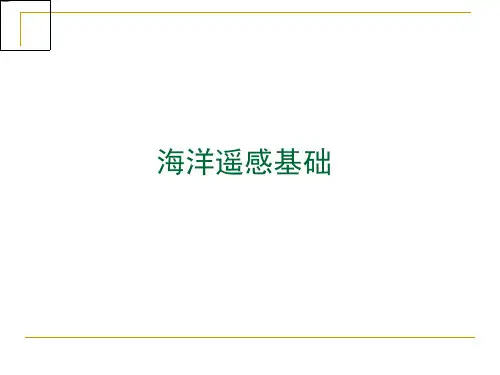
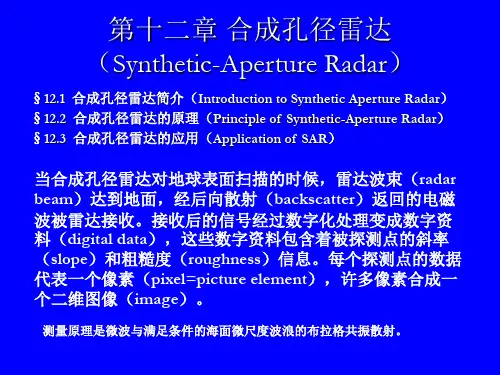
![卫星海洋学试题[最终版]](https://uimg.taocdn.com/3ec99cd4ed630b1c58eeb519.webp)
问答题§11.1 复习题〔Questions for Review 〕第一套复习题1.请将以下电磁波按频率由小到大排序:C波段、Ku波段、X波段、红光、蓝光、绿光、紫外光、黄光、黄绿光、近红外、远红外、无线电波。
2.什么波长范围的电磁波称为可见光?其对应的频率范围是什么?3.菲涅耳反射率与发射率有何关系?与吸收率、透射率的关系?推导顶用了什么定律?举出两个例子a〕在海水可见光红外波段情况下b〕在海水微波波段情况下菲涅耳反射系数和反射率的数值。
4.写出德拜方程的表达式。
为什么L 波段的微波辐射计适于测海外表盐度?相对电容率的变化通过什么公式导致辐射计接收到的亮温etTs 也随之变化?5.写出普朗克定律的表达式,解释公式中呈现的每一个物理量和常数,并由此推导瑞利—金斯定律。
这两个定律别离适用于红外、可见光、微波波段三个波段中哪些波段的辐射度计算?6.简要阐述米氏散射和瑞利散射的适用条件。
大气层空气分子的散射属于那一种?气溶胶散射对可见光、红外和微波〔例如 5.3GHz〕波段各属于那一种?指出气溶胶粒径的主要分布范围和 5.3GHz微波波长。
7.别离写出兰伯—比尔定律的微分和积分形式,并指出衰减系数与复折射率的关系。
8.写出水色遥感大气校正的最根本方程,并介绍各项的物理意义。
指出在440 纳米和清洁水条件下,各项对卫星信号的奉献占多少?SeaWiFs为例,利10. 画出典型的一类水体叶绿素的离水辐射的光谱曲线图。
以用那两个波段〔用中心波长暗示〕的离水辐亮度的比值可以反演叶绿素浓度?该方法通常又叫什么名字?11. 别离写出镜面反射和布喇格共振理论计算尺度化雷达后向散射截面σ0 的公式。
二者通过什么函数与风速相联系?12. 解释概念:Range,Geoid,Topography,Dynamic height ,Geoid Undulation ,Reference Ellipsoid 。
大地水准面起伏主要是由什么原因引起〔答复一个最主要原因〕?其变化的范围是什么?海面地形是由什么原因引起〔答复三个最主要原因〕?其变化的范围是什么?13. 卫星到海面距离如何测得?Topex/Poseidon 测量海平面高度的精度精度可达多少?海面到地心的距离如何计算?海面地形异常可用什么公式计算?14. 写出合成孔径雷达的纵向距离分辨率。
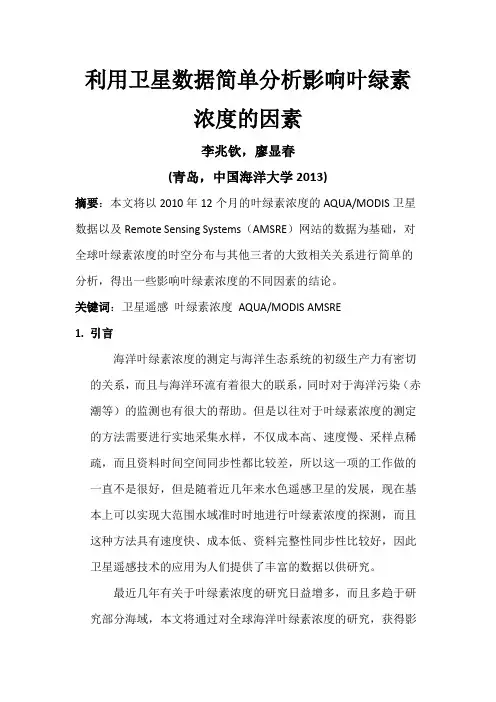
利用卫星数据简单分析影响叶绿素浓度的因素李兆钦,廖显春(青岛,中国海洋大学2013)摘要:本文将以2010年12个月的叶绿素浓度的AQUA/MODIS卫星数据以及Remote Sensing Systems(AMSRE)网站的数据为基础,对全球叶绿素浓度的时空分布与其他三者的大致相关关系进行简单的分析,得出一些影响叶绿素浓度的不同因素的结论。
关键词:卫星遥感叶绿素浓度AQUA/MODIS AMSRE1.引言海洋叶绿素浓度的测定与海洋生态系统的初级生产力有密切的关系,而且与海洋环流有着很大的联系,同时对于海洋污染(赤潮等)的监测也有很大的帮助。
但是以往对于叶绿素浓度的测定的方法需要进行实地采集水样,不仅成本高、速度慢、采样点稀疏,而且资料时间空间同步性都比较差,所以这一项的工作做的一直不是很好,但是随着近几年来水色遥感卫星的发展,现在基本上可以实现大范围水域准时时地进行叶绿素浓度的探测,而且这种方法具有速度快、成本低、资料完整性同步性比较好,因此卫星遥感技术的应用为人们提供了丰富的数据以供研究。
最近几年有关于叶绿素浓度的研究日益增多,而且多趋于研究部分海域,本文将通过对全球海洋叶绿素浓度的研究,获得影响叶绿素浓度的相关性因素,并简要给出其关系。
2.数据来源本文所用的(1)叶绿素数据为aqua\modis的L3(L2~L4:是对LlB数据进行各种应用处理之后所生成的特定应用数据产品。
)数据产品,数据的空间分辨率为9km,选择的时间段是2010年12个月平均的数据。
MODIS是当前世界上新一代“图谱合一”的光学遥感仪器,有36个离散光谱波段,光谱范围宽,从0.4微米(可见光)到14.4微米(热红外)全光谱覆盖。
MODIS的多波段数据可以同时提供反映陆地表面状况、云边界、云特性、海洋水色、浮游植物、生物地理、化学、大气中水汽、气溶胶、地表温度、云顶温度、大气温度、臭氧和云顶高度等特征的信息。
可用于对地表、生物圈、固态地球、大气和海洋进行长期全球观测。
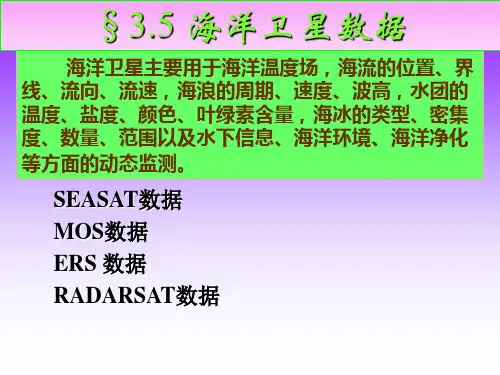
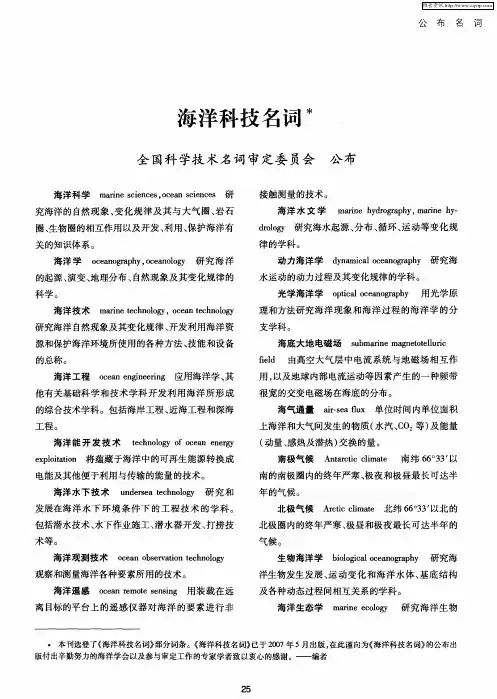
卫星海洋学教材
以下是关于卫星海洋学的教材:
《卫星海洋学》,刘玉光主编,高等教育出版社出版。
这是一本系统介绍卫星海洋学基本原理、观测方法、数据处理和应用的教材,内容涵盖了卫星海洋学的基本概念、卫星轨道和观测平台、卫星遥感原理、海表温度和海面风场观测、海浪和海面高度观测、海冰和海洋表面动力场观测以及卫星资料处理和应用等方面的知识。
此外,还有《卫星气象观测:海洋气象应用技术》,谢涛编著,气象出版社出版。
这本书介绍了卫星气象观测在海洋气象中的应用技术,包括卫星气象观测原理、遥感图像处理、气象信息提取等方面的内容。
如需了解更多关于卫星海洋学的教材,建议咨询海洋科学专业教师或访问图书馆等资源库。
军事海洋学专业教学计划学科门类理学专业代码 071004w 毕业学位理学学士(从2006级本科生开始执行)一、培养目标培养具有海洋科学(特别是物理海洋学)扎实的理论基础、丰富的专业知识、较强的实践能力,能够在开发利用海洋、为国防安全提供海洋环境保障、维护国家海洋权益等领域从事科研、教学和科技开发工作的专门人才。
二、培养规格具有扎实的数学、物理、化学、外语、计算机应用基础;系统而坚实地掌握海洋科学的,特别是物理海洋学的基本理论、基本知识和应用技能;计算机应用能力较强;熟练使用外语阅读文献和进行交流;受到较好的海洋科学研究的训练,并对海洋科学在军事领域的应用有一定了解;具有良好科学素养和创新精神、较强的自学能力和独立工作的业务能力。
三、实践环节必修实践环节1.普通物理学实验153学时/4.5学分 6.近海海上调查实践34学时/1学分2.流体力学实验34学时/1学分7.海洋调查Ⅰ17学时/0.5学分3.海洋调查实习2周/2学分8.海洋要素计算17学时/0.5学分4.海洋科学类见习1周/1学分9.毕业论文16周/10学分5.海洋数据处理及可视化实践34学时/1学分选修实践环节1.计算机实习(包括上网) 34学时/1学分2.物理海洋实验34学时/1学分学生参加本科生研究训练计划(SRTP)等,可按规定获相应学分。
四、学分分配项目准予毕业本科通识教育层面学科基础教育层面专业知识教育层面工作技能教育层面要求学分170.5 68.5 45.5 37.5 19五、课程设置1、本科通识教育层面最低要求学分:68.5 其中:必修57学分;限选11.5学分修课要求课程编号课程名称课程英文名称学分学时先修课程建议选修学期讲授实践必修008101101023思想道德修养和法律基础Ideological and MoralCultivation and theBasic Course of Law3 51 1 008101101019毛泽东思想、邓小平理论和三个代表重要思想概论An Outline of MaoZedong Thought, DengXiaoping Theory andthe Important Thoughtof Three Represents6 68 34 2或3 008101101025中国近现代史纲要Summary of ChineseContemporary andModern History2 34 2或3008101101021 马克思主义基本原理Basic Principles ofMarxism3 51 3或4 008101101013形势与政策ⅠCurrent Situation andPolicy Ⅰ 0.5 17 2 008101101015 形势与政策Ⅱ Current Situation and Policy Ⅱ0.5 17 4008301101031 大学英语预备级 Probationary College English2 68 四年开课不断线,修满16学分即可008301101033 大学英语Ⅰ College English Ⅰ 4 68 008301101035 大学英语Ⅱ College English Ⅱ 4 68 008301101037 大学英语Ⅲ College English Ⅲ 4 68 008301101039 大学英语Ⅳ College English Ⅳ 4 68 008301101041 大学英语V College English Ⅴ 4 68 008301101043大学英语VICollege English Ⅵ 4 68 或另外一种外语的各个等级课程 OtherForeignLanguages16008201103019 体育Ⅰ Physical Education Ⅰ 1 2 32 四年开课不断线008201103021 体育Ⅱ Physical Education Ⅱ 1 2 32 008201103023 体育Ⅲ Physical Education Ⅲ 1 2 32 008201103025 体育Ⅳ Physical Education Ⅳ 12 32 008201101027 军事科学概论 An Introduction toMilitary Science2 34 1 008201101029 军事训练 Military Affairs Training 1 2周 1 008401101073 高等微积分I Advanced Calculus I 6 1021 008401101075 高等微积分II Advanced Calculus II 4 68 高等微积分I2 008401101059 线性代数 Linear Algebra 351 3 008501101103大学计算机基础Fundamentals of Computers 334341008501101077Fortran 程序设计 Programming withFortran Language3 34 34 2限选 至少修满11.5学分的本科通识教育限选课程(不可选通识课中的海洋学)。
第一章2、名词解释:El Niño、La Niña、ENSO、TOGA、TAO、NOAA/TIROS、TOPEX/Poseidon。
El Niño :厄尔尼诺(El Niño)在西班牙语中的意思是“圣婴”。
厄尔尼诺是指赤道太平洋东部和中部海表面温度持续异常偏高的现象,该现象首先发生在南美洲的厄瓜多尔和秘鲁太平洋沿岸附近,多发生在圣诞节前后,因此得名。
La Niña :拉尼娜(La Niña)的意思是“小女孩”。
拉尼娜现象表现为赤道太平洋东部和中部海表面温度持续异常偏低。
ENSO:赤道太平洋海面水温的变化与全球大气环流尤其是热带大气环流紧密相关。
其中最直接的联系就是日界线以东的东南太平洋与日界线以西的西太平洋—印度洋之间海平面气压的反相关关系,即南方涛动现象(SO)。
在拉尼娜期间,东南太平洋气压明显升高,印度尼西亚和澳大利亚的气压减弱。
厄尔尼诺期间的情况正好相反。
鉴于厄尔尼诺与南方涛动之间的密切关系,气象上把两者合称为ENSO。
TOGA:热带海洋和全球大气计划。
为了研究热带海洋和全球大气的月际到年际变化,从而推动气候变化及异常气象问题的研究,提高和改善海洋环境和气候预报能力,政府间海洋学委员会和世界气象组织共同发起了热带海洋和全球大气研究计划(toga)。
该计划分准备阶段、外业调查阶段和室内资料分析整理三个阶段,从1985年到1995年,共进行10年。
其中,第一个5年为普查阶段,第二个5年为详查阶段,即所谓加强监视期。
在第二个5年中,又设计了一个连续四个月的加密调查阶段,即所谓强化观测期。
The Tropical Ocean Global Atmosphere program (TOGA) is evolving into an operational El Nino/Southern Oscillation (ENSO) observing system. TOGA started in January 1985 and ended in December 1994. The four major elements of this observing system are: 1) a volunteer observing ship expendable bathythermograph program; 2) an island and coastal tide gauge network; 3) a drifting buoy program; 4) a moored buoy program consisting of wind and thermal chain moorings and current meter moorings. The crowning achievement of TOGA was the development of the Tropical Atmosphere/Ocean (TAO) array。
TAO:热带大气海洋。
The TAO array (renamed the TAO/TRITON array on 1 January 2000) consists of approximately 70 moorings in the Tropical Pacific Ocean, telemetering oceanographic and meteorological data to shore in real-time via the Argos satellite system. The array is a major component of the El Niño/Southern Oscillation (ENSO) Observing System, the Global Climate Observing System (GCOS) and the Global Ocean Observing System (GOOS). Support is provided primarily by the United States (National Oceanic and Atmospheric Administration) and Japan (Japan Marine Science and Technology Center) with additional contributions fromFrance (Institut de recherche pour le developpement). The TAO array is directed by NOAA's Pacific Marine Environmental Laboratory (PMEL) and involves international cooperation with scientists and organizations in U.S.A., Japan, France, Korea, and Taiwan (of China)。
NOAA/TIROS是太阳同步极轨气象卫星,也被称为极轨业务环境卫星,该卫星可为全球各国提供免费的当地数据接收服务。
TOPEX/Poseidon是在1992年8月,由美国宇航局(NASA)和法国国家空间研究中心(CNES)联合发射的高度计专用卫星。
6、阅读下列网站之一,并使用中文和英文做出简要的介绍(不超过5号纸2页):a) 欧空局的网页http://earth.esa.int/ers/satconc/中关于欧洲遥感卫星ERS-1/2的介绍。
The satellite concept is based on the re-utilisation of the Multi-mission Platform, developed within the French SPOT programme. This platform provides the major services for the satellite and payload operation, in particular attitude and orbit control, power supply, monitoring and control of payload status, telecommunications with the ground segment.To meets its mission objectives, ERS-1 has been placed in a near-polar orbit at a mean altitude of about 780 km with an instrument payload comprising active and passive microwave sensors and a thermal infra-red radiometer. The satellite (see the figure) is large, weighing 2400 kg and measuring 12 m x 12 m x 2.5 m, making it the largest and most sophisticated free-flying satellite built so far in Europe.The spacecraft platform provides the major services required for satellite and payload operation. These include attitude and orbit control, power supply, monitoring and control of payload status, telecommunication with ground stations and telemetry of payload and platform housekeeping data. In addition, the PRARE instrument is mounted on the platform.The platform was modified with respect to the SPOT programme to meet the unique needs of the ERS-1 mission. The major modifications included extension of the solar array power and battery energy storage capability; modification of the attitude control sub-system to provide yaw steering and geodetic pointing; and the development of new software for payload management and control.The platform structure is a rigid framework, with the load of the instruments transmitted directly through a central tube by metal struts.ERS-2's passive instrument load includes an along-track (i.e. in the direction of flight) scanning radiometer equipped with six channels in the infrared and visible parts of the spectrum. The three channels in the visible spectrum are new and are used to observe vegetation, for example for crop forecasting or monitoring of deforestation.The GOME, which stands for global ozone monitoring experiment, is an entirely new passive instrument which will monitor the ozone content of the atmosphere with anprecision hitherto unobtainable from space. This highly sophisticated spectrometer was developed by ESA in the record time of five years.Two further instruments on board ERS-2 will serve to enhance the accuracy of other instruments. These are PRARE (precise range and range rate equipment) units, which will have the task of measuring the satellite's orbit with outstanding precision, and a microwave sounder to determine atmospheric humidity.“欧洲遥感卫星”ERS-1 和ERS-2分别于1991年和1995年由欧空局发射。